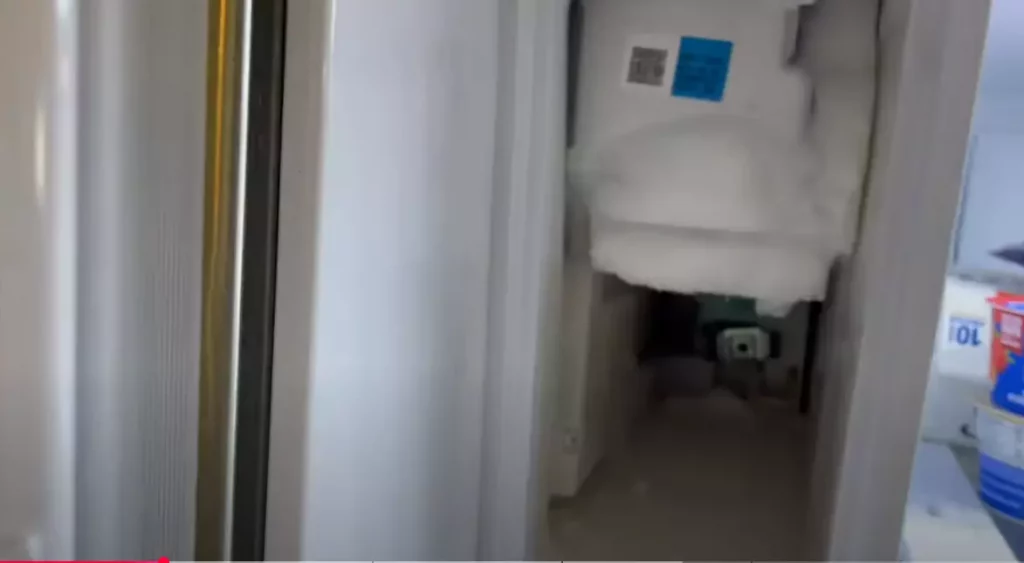Introduction:
Welcome to our series on a frozen Samsung French Door Refrigerator ice maker! If your ice maker is visibly encased in ice or jammed due to frost buildup, initiating a Forced Defrost cycle is one of the quickest (albeit temporary) ways to get it operational again. This article, Method 2, will guide you through how to do this.

Remember, this method primarily melts existing ice and doesn’t address the root cause of your ice maker’s freezing up. For a more permanent solution to prevent recurrence, please refer to Method 1: Sealing the Ice Maker Compartment and other upcoming articles in this series.
Disclaimer: This guide is for informational purposes. While activating forced defrost via the control panel is generally safe, always exercise caution when dealing with appliances. If you are unsure, consult your user manual or a qualified technician. This specific procedure does not require unplugging the refrigerator.
When to Use the Forced Defrost Cycle for an Iced-Up Ice Maker:
- Your ice maker compartment is full of frost or ice, and components appear frozen together.
- You need a quick, temporary solution to get some ice production started again.
- As a first step before attempting more involved manual defrosting or disassembly (like that covered in Method 3 or when preparing for Method 1).
How to Activate and Use the Forced Defrost Cycle: see Samsung RF28HMEBSR forced defrost.
The button combination to enter Forced Defrost mode can vary slightly between Samsung French Door models. Here are the most common sequences :
- Common Button Combination 1 (Often for models like RF28HFEDBSR):
- Press and hold the Energy Saver button AND the Fridge (refrigerator temperature) button simultaneously.
- Continue holding for approximately 8-10 seconds. The display will go blank, and you’ll likely hear a beep.
- Common Button Combination 2 (Some other models):
- Press and hold the Freezer (freezer temperature) button AND the Lighting (or Door Alarm/Ice Off, depending on panel layout) button simultaneously for a similar duration (8-10 seconds) until the display blanks and beeps.
- Entering the “Fd” (Force Defrost) Mode:
- Release the buttons once the display is blank and has beeped (indicating you’re in a special diagnostic/test mode).
- Repeat the Fridge button (or whichever temperature button was not part of the initial combination, or sometimes any button) to cycle through different test modes.
- You want “Fd” to appear on the display. “Fd stands for “Force Defrost.”
- Running the Forced Defrost Cycle:
- Once “Fd” is displayed, the refrigerator enters the forced defrost mode. While in this mode, you will likely hear the refrigerator beep periodically.
- The internal defrost heater(s) will activate. This will melt frost from the primary evaporator coils in the fresh food compartment, and importantly for our purpose, it will also help to thaw out the ice maker compartment and surrounding components.
- Allow the refrigerator to remain in this “Fd” mode for approximately 10-15 minutes. This should be sufficient to melt a significant amount of ice in and around the ice maker assembly without overheating any components. (The Parts Dr. video mentions 5-10 minutes, which is also a good guideline for the ice maker area.)
Step 5: Exiting the Forced Defrost Cycle
- To exit the Forced Defrost mode, you typically press and hold the buttons you used to enter the diagnostic mode (e.g., Energy Saver + Fridge) for about 8-10 seconds until the display goes blank and beeps again, returning to its standard temperature display.
- Alternatively, some models may automatically exit the forced defrost cycle after a predetermined time (e.g., 20-30 minutes for a complete system defrost, but you’ll likely exit manually before then for this specific purpose). Unplugging and replugging the fridge will also reset it to regular operation.
What to Expect After Forced Defrost:
- The compartment and the ice maker should be significantly less icy or completely ice-free.
- The ice maker compartment will take some time to cool to its optimal ice-making temperature.
- Don’t expect ice immediately. Allow the ice maker to cycle and produce new ice for several hours (at least 4-6, possibly more).
- Once it’s safe, you may need to manually remove any partially melted ice or water from the ice bucket and the ice maker area.
Important Considerations:
- This is a temporary fix. If the underlying cause of the excessive icing (like poor sealing—see Method 1) is not addressed, the ice maker will likely freeze again.
- Frequency: You shouldn’t need to use forced defrost regularly. If you find yourself doing this every few days or weeks, it’s a strong indicator of a more significant problem that needs a permanent solution.
- Not a Replacement for Proper Repair: Forced defrost helps manage the symptom (ice buildup) but doesn’t fix the cause.
Conclusion:
The Forced Defrost cycle can be a useful “emergency” tool to quickly melt away ice, preventing your Samsung French Door refrigerator’s ice maker from working. It’s a simple, non-invasive first step to try. However, the root causes for lasting relief should be investigated, and more permanent fixes, like sealing the compartment (Method 1) or other repairs detailed in our series, should be considered.
Stay tuned for Method 3, where we’ll discuss manually defrosting and cleaning the ice maker for a more thorough ice removal.
